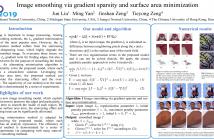
- Read more about Towards Unsupervised Single Image Dehazing with Deep Learning
- Log in to post comments
Deep learning computation is often used in single-image dehazing techniques for outdoor vision systems. Its development is restricted by the difficulties in providing a training set of degraded and ground-truth image pairs. In this paper, we develop a novel model that utilizes cycle generative adversarial network through unsupervised learning to effectively remove the requirement of a haze/depth data set. Qualitative and quantitative experiments demonstrated that the proposed model outperforms existing state-of-the-art dehazing models when tested on both synthetic and real haze images.
- Categories:
 96 Views
96 Views
- Read more about Image smoothing via gradient sparsity and surface area minimization
- Log in to post comments
Image smoothing is a very important topic in image processing. Among these image smoothing methods, the $L_0$ gradient minimization method is one of the most popular ones. However, the $L_0$ gradient minimization method suffers from the staircasing effect and over-sharpening issue, which highly degrade the quality of the smoothed image. To overcome these issues, we use not only the $L_0$ gradient term for finding edges, but also a surface area based term for the purpose of smoothing the inside of each region.
- Categories:
 54 Views
54 Views
- Read more about 5D Video Stabilization through Sensor Vision Fusion
- 1 comment
- Log in to post comments
- Categories:
 151 Views
151 Views
- Read more about Dense Optical Flow for the Reconstruction of Weakly Textured and Structured Surfaces: Application to Endoscopy
- Log in to post comments
- Categories:
 20 Views
20 Views
- Read more about Evaluating Crowd Density Estimators via Their Uncertainty Bounds
- 1 comment
- Log in to post comments
- Categories:
 19 Views
19 Views
- Read more about A LIGHTWEIGHT NEURAL NETWORK FOR CROWD ANALYSIS OF IMAGES WITH CONGESTED SCENES
- Log in to post comments
For images with congested scenes, the task of crowd analysis,
including crowd counting and crowd distribution prediction,
becomes very difficult. To address these issues, various
CNN-based approaches have been proposed. However, those
methods usually have a large number of parameters and require
huge computing resources. In this paper, we focus on
low-complexity approaches and propose a lightweight endto-
end network for crowd analysis. Our method utilizes an
effective scale-aware module to extract multi-scale features
- Categories:
 21 Views
21 Views
- Read more about Dense Optical Flow for the Reconstruction of Weakly Textured and Structured Surfaces: Application to Endoscopy
- 1 comment
- Log in to post comments
- Categories:
 15 Views
15 Views
- Read more about Estimation of Multiple Atmospheric Pollutants Through Image Analysis
- Log in to post comments
Multiple atmospheric pollutants, such as PM2.5, PM10, and NO2, degrades air quality in many parts of the world. Fine-grained air pollution data can help combat the problem, but conventional monitoring stations are too expensive to support high spatial resolution; image-based estimates have the potential to improve spatial coverage. We estimate pollutant concentrations from images using the position-and color-dependent properties of scattering and absorption. We are the first to use images to estimate pollutant concentrations in systems with multiple pollutants.
- Categories:
 33 Views
33 Views
- Read more about Dense Optical Flow for the Reconstruction of Weakly Textured and Structured Surfaces: Application to Endoscopy
- 1 comment
- Log in to post comments
This paper introduces a structure from motion (SfM)-based surface reconstruction method for images including weak textures and structures. In SfM, the quality of the determination of homologous points between images plays a key role in terms of reconstruction performances. However, classical feature matching-based methods as integrated in the state-of-the-art SfM algorithms are often inoperative for images with weak structures and textures. This contribution describes a dense optical flow-based solution enabling the point correspondence determination in such scenes.
- Categories:
 33 Views
33 Views
- Read more about Dense Optical Flow for the Reconstruction of Weakly Textured and Structured Surfaces: Application to Endoscopy
- 1 comment
- Log in to post comments
This paper introduces a structure from motion (SfM)-based surface reconstruction method for images including weak textures and structures. In SfM, the quality of the determination of homologous points between images plays a key role in terms of reconstruction performances. However, classical feature matching-based methods as integrated in the state-ofthe-art SfM algorithms are often inoperative for images with weak structures and textures. This contribution describes a dense optical flow-based solution enabling the point correspondence determination in such scenes.
- Categories:
 44 Views
44 Views